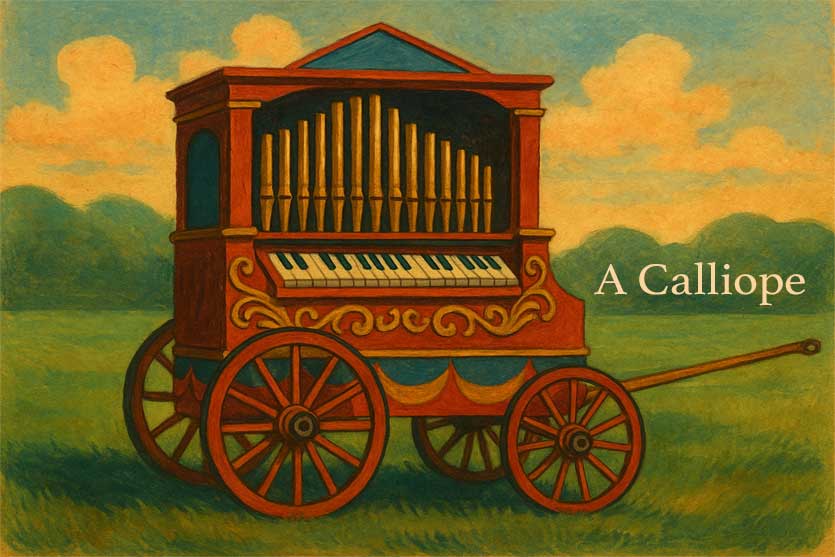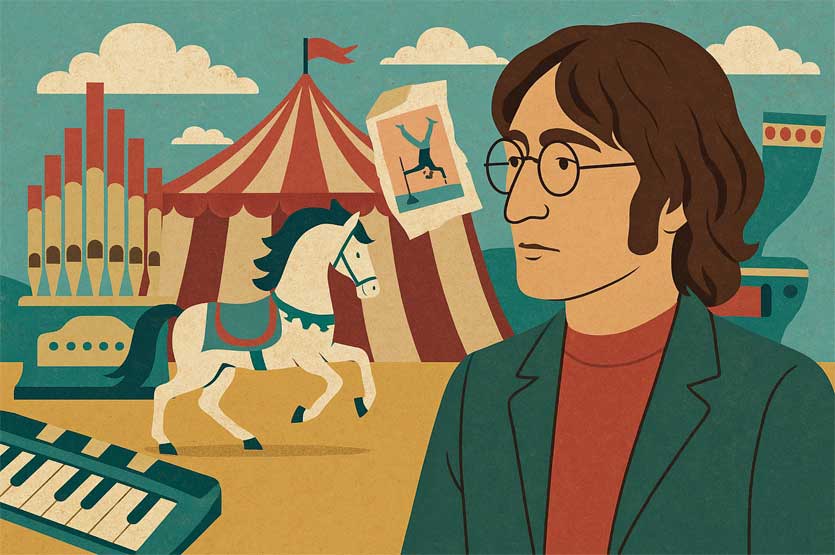What inspires a composer or songwriter? Sometimes it’s a deep emotion, sometimes a political cause, and sometimes — as in John Lennon’s case in early 1967 — it’s a Victorian circus poster.
A Day in Knole Park, A Poster in the Window
While The Beatles were filming promotional clips for Strawberry Fields Forever and Penny Lane in Knole Park, Kent, Lennon slipped away to browse an antiques shop. His eye caught an 1843 poster for Pablo Fanque’s Circus Royal in Rochdale.
The poster brimmed with whimsical imagery — a man balancing on his head playing a trumpet, colourful descriptions of acts, and a proud listing of the performers. Lennon loved it, bought it, and hung it above his piano.
Two weeks later, Being for the Benefit of Mr Kite was ready — the lyrics drawn almost word-for-word from the poster itself.
“Everything in that song is from that poster, except the horse wasn’t called Henry.” — John Lennon
Lennon’s Humour and the Piano Connection
Lennon’s humour had two distinct sides — sharp, caustic wit and a love of the absurd. The circus poster appealed to the latter. Hung above his piano, it became not just wall decoration but a creative trigger.
For piano learners, this is a powerful reminder: where you practice matters. Surround yourself with objects, images, or sounds that put you in a creative state of mind. Inspiration can live on your wall just as easily as in your music books.
Bringing the Circus to Abbey Road
When Lennon brought Mr Kite to the studio, he told producer George Martin he wanted the song to sound like “a circus in full swing — you should smell the sawdust.”
Martin’s team couldn’t locate a real calliope in London, so they spliced together recordings of one, rearranging the tape pieces into a swirling fairground soundscape. Layered on top were multiple keyboard parts: Hammond organ, harmonium, mellotron, piano, Lowrey organ, and Wurlitzer.

For pianists, it’s a case study in how keyboard instruments can do more than play melody — they can set an entire scene, from dreamy to chaotic, using tone, rhythm, and texture.
BBC Bans and Beatles Resilience
When Sgt. Pepper’s Lonely Hearts Club Band was released in May 1967, Mr Kite was track seven in an album that redefined popular music. The BBC promptly banned it, insisting that “Henry the horse” was slang for heroin. Lennon’s likely reply? Sometimes a horse is just a horse.
Despite the ban — and the press’s giddy speculation that the Beatles’ reign was over when Penny Lane failed to hit number one — the album topped the UK charts for six months, outselling even Thriller, Rumours, and Dark Side of the Moon.
Lessons for the Piano Player
- Keep your eyes open for inspiration. Lennon found a song in a poster. Your next practice breakthrough might come from a film, a photograph, or a street musician.
- Transform what you already have. Lennon edited and arranged the poster’s words. Pianists can take a simple chord progression and turn it into something original.
- Experiment with sound. Just as Martin layered multiple keyboards for atmosphere, try shifting between piano tones, rhythms, and dynamics to create new moods.
- Keep your eyes open for inspiration. Lennon found a song in a poster. Your next practice breakthrough might come from a film, a photograph, or a street musician.
- Transform what you already have. Lennon edited and arranged the poster’s words. Pianists can take a simple chord progression and turn it into something original.
- Experiment with sound. Just as Martin layered multiple keyboards for atmosphere, try shifting between piano tones, rhythms, and dynamics to create new moods.
When Lennon stared at that circus poster above his piano, he didn’t know it would produce one of the most distinctive tracks on Sgt. Pepper. But that’s the beauty of creative work — the spark can come from anywhere, and the piano is always ready to turn it into music.
So the next time you sit down to play, remember Lennon’s Mr Kite: a reminder that inspiration can be as close as the wall above your piano — and as wild as your imagination.



